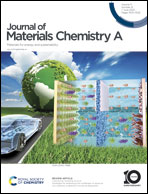Self-powered, ultra-broadband, and polarization-sensitive photodetectors based on 1D van der Waals layered material Nb2Pd3Se8†
Abstract
Ultra-broadband high-performance photodetectors (PDs) are promising for diverse applications such as communication, imaging, environmental monitoring, and sensing. However, many PDs currently face issues of slow response speed, low sensitivity, poor air stability, and high energy consumption. In this work, we demonstrate a self-powered, broadband, and polarization-sensitive PD based on a ternary transition metal chalcogenide Nb2Pd3Se8 single crystal. The generation mechanism of photocurrent (PC) was confirmed by photoresponse measurements related to laser power and temperature. The Nb2Pd3Se8-based PD exhibits the maximum responsivity of 2.74 mA W−1 and a detectivity of 4.73 × 106 Jones with a 55–60 ms response time at 532 nm and high stability under ambient conditions over 6 months. Broadband detection capabilities from 365 nm to 10.6 μm are tested experimentally. Moreover, a strong polarization-sensitive PD with an anisotropic ratio of 1.42 is achieved. This work exhibits the enormous potential of Nb2Pd3Se8 for ultra-broadband, self-powered, polarization-sensitive, and air-stable PDs.

- This article is part of the themed collections: Journal of Materials Chemistry A Emerging Investigators and #MyFirstJMCA


 Please wait while we load your content...
Please wait while we load your content...